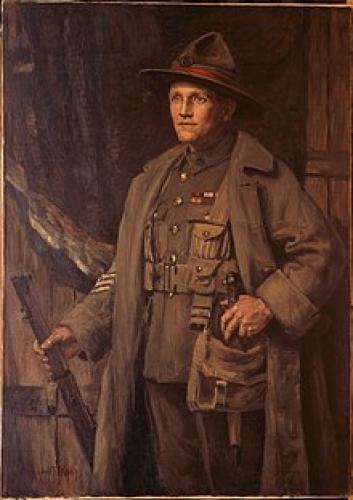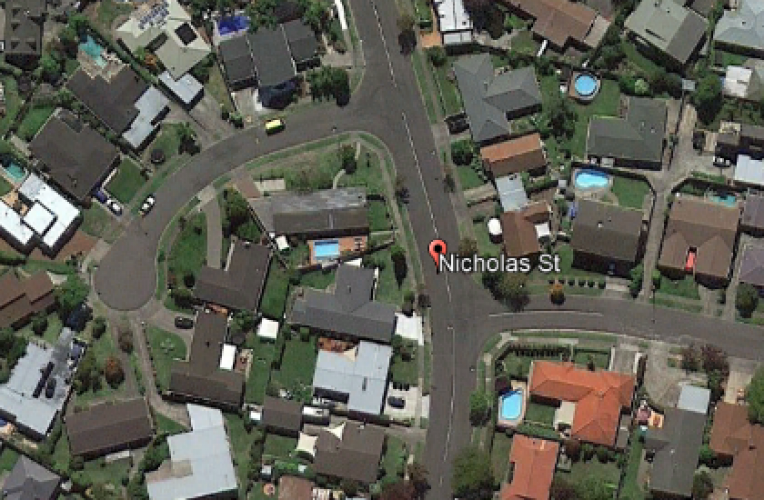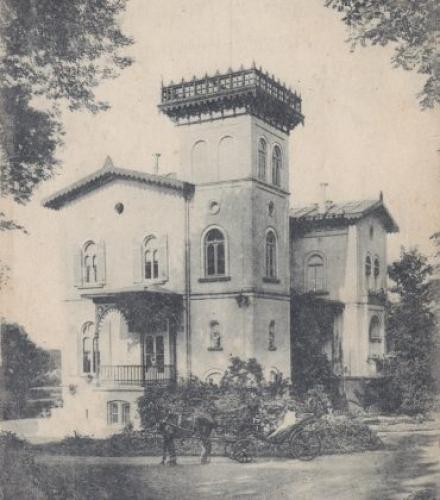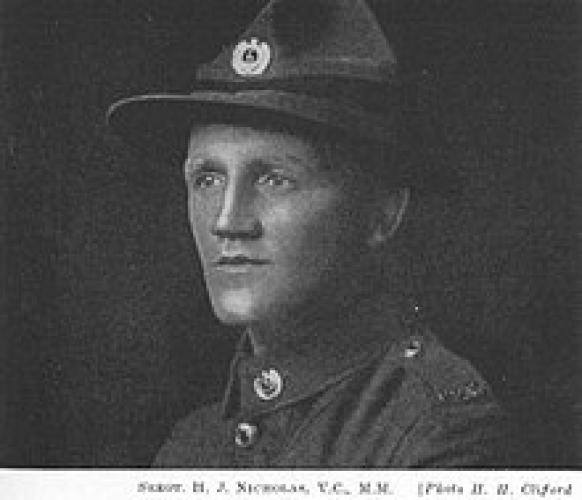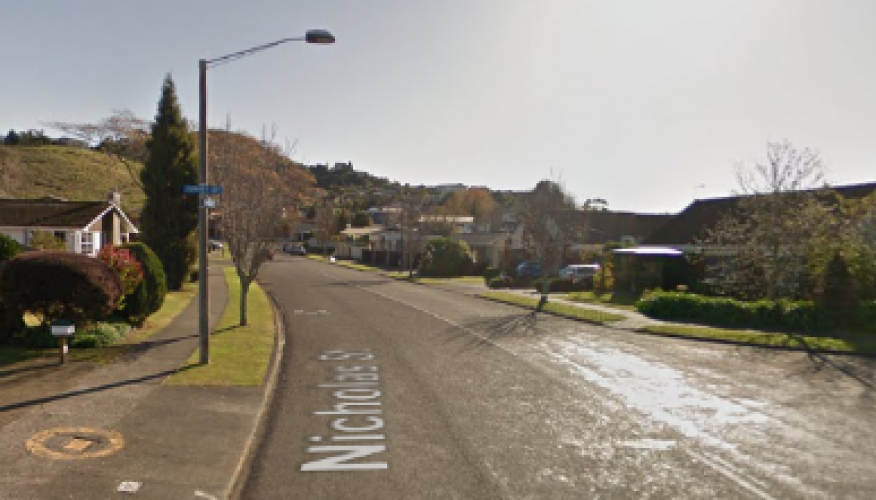229 Nicholas Street Taradale, Napier, street scene 2018
Reason for the name
This Taradale Street was named in honour of Sergeant Henry James Nicholas VC, MM. The Napier City Council has named several streets in the suburb of Taradale after Victoria Cross winners.
Henry Nicholas arrived in France in September 1916 and saw action at the Somme. He was involved in many of the actions fought by the New Zealand Division in 1917, including the successful attack on Messines ridge on 7 June. He missed the battle of Passchendaele due to illness but re-joined his Canterbury Regiment in time for the Polderhoek attack on 3 December. His actions there earned him the Victoria Cross.
During the advance on Polderhoek, Nicholas’s section was held up by heavy machine-gun and rifle fire. He single-handedly rushed the enemy position from the rear, threw a grenade and shot the officer. He then charged the remaining occupants with his bayonet. When the smoke cleared, 12 Germans lay dead. Four survivors were taken prisoner. Recommending him for an award, his commanding officer noted 'His fearless example and devotion to duty, commands him to special recognition.'
In mid-1918, while in England on leave, Nicholas was invested with his Victoria Cross by the King. After his return to the front in September 1918, the Canterbury Regiment was charged with holding the town of Beaudignies, a short distance from Le Quesnoy. On 23 October a German patrol blundered into Nicholas’s post on a flank guarding a bridge over the River Ecaillon. During this skirmish, Nicholas was killed by heavy machine-gun fire from the high ground of Le Quesnoy. He was posthumously awarded the Military Medal for his bravery during this action.
Author: The Poppy Places Trust
Henry James Nicholas, VC, MM (11 June 1891 – 23 October 1918) was a New Zealand recipient of the Victoria Cross, the highest award for valour "in the face of the enemy" that can be awarded to British and Commonwealth forces.
Nicholas was born in Lincoln, near Christchurch, in New Zealand on 11 June 1891 to Richard and Hannah Nicholas and was one of four boys. He did his schooling in Christchurch, first at Christchurch Normal School and later at Christchurch East School. After completing his education, he took up an apprenticeship to a builder, learning carpentry. He later worked in Australia for four years. On returning to New Zealand in 1915, he joined New Zealand's part-time militia, the Territorial Force, and served in the Field Engineers.
In February 1916, Nicholas enlisted in the New Zealand Military Forces, giving his occupation as a carpenter. Volunteering for service abroad with the New Zealand Expeditionary Force (NZEF), he embarked for Europe three months later with the 13th Reinforcements. After an initial period at the NZEF training facilities at Sling Camp in England, where he was the regimental boxing champion in the middle-weight class, he was sent to the Western Front and posted to the 1st Battalion of the Canterbury Regiment with the rank of private.
Nicholas' battalion was part of the 2nd Infantry Brigade, New Zealand Division, and in mid-1917 took part in the Battle of Messines. A few months later, the battalion was operating in the Ypres Salient and actively engaged in the Battle of Passchendaele. Towards the end of the year, his battalion was involved in an attack on Polderhoek Chateau on 3 December 1917. The chateau, atop the Polderhoek Spur in the Ypres Salient and held by the Germans, overlooked the trenches occupied by the brigade. Its Canterbury and Otago battalions attacked midday but both were slowed by heavy machine-gun fire. It was then that Nicholas performed the actions that led to the award of the Victoria Cross (VC). The VC, instituted in 1856, was the highest award for valour that could be bestowed on a soldier of the British Empire. His VC citation read as follows:
For most conspicuous bravery and devotion to duty in attack. Private Nicholas, who was one of a Lewis gun section, had orders to form a defensive flank to the right of the advance, which was checked by heavy machine-gun and rifle fire from an enemy strong-point. Whereupon, followed by the remainder of his section at an interval of about 25 yards, Private Nicholas rushed forward alone, shot the officer in command of the strong-point, and overcame the remainder of the garrison of sixteen with bombs and bayonets, capturing four wounded prisoners and a machine-gun. He captured this strong-point practically single-handed, and thereby saved many casualties. Subsequently, when the advance reached its limit, Private Nicholas collected ammunition under heavy machine-gun and rifle fire. His exceptional valour and coolness throughout the operations afforded an inspiring example to all.
— The London Gazette, No. 30472, 11 January 1918
The advance resumed but ground to a halt 150 yards (140 m) short of the chateau where the New Zealanders established a new front line. During this phase of attack, Nicholas moved along the lines, collecting and distributing ammunition. What was left of the Canterbury and Otago battalions was relieved on 5 December 1917. The award of the VC to Nicholas was gazetted in January 1918. Shortly afterwards, the New Zealand Division was withdrawn from the Ypres sector for a rest, but it was recalled when the Germans launched their Spring Offensive. Nicholas' battalion was dispatched to the Somme on 23 March 1918. Along with the rest of the division it helped stabilise the front until it was placed in reserve in June.
In July 1918 Nicholas was sent to England where he was presented with his VC by King George V at an investiture at Buckingham Palace, having been promoted to sergeant the previous month. During the Hundred Days Offensive, he was awarded the Military Medal (MM) for actions performed in late September to early October 1918 during operations on Welsh and Bon Avis Ridges. On 23 October 1918, he was performing guard duty at a bridge near Le Quesnoy when a German patrol encountered his position. He was killed during the ensuing exchange of gunfire. He was buried in the Vertigneul Churchyard on 29 October 1918, and the award of his MM was gazetted in March 1919. The citation made note of his "fearless leadership and contempt for danger".

